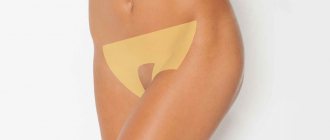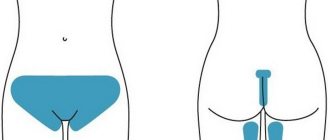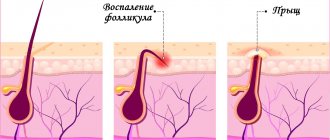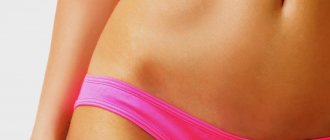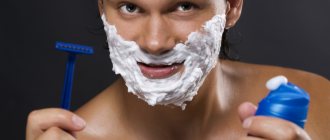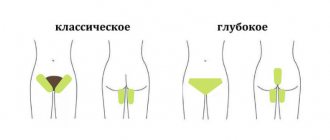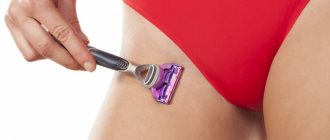The skin in the bikini area is very sensitive. Constant mechanical impact, as happens when shaving, waxing or sugaring, can cause irritation, itching, red spots and, most unpleasantly, ingrown hairs. The photoepilation procedure can also be painful and can have negative consequences, but in practice, there are much more positive reviews about this method than negative ones. Photoepilation is chosen by patients who want long-lasting results. To “suffer” several procedures, and then walk with smooth skin for 2–4 years.
Photoepilation device
For this method of removing unwanted vegetation, a special device called a photoepilator is used. Its main feature is the lamps that distribute the photostream onto the skin.
Light penetrates deep into the skin, affecting the hair roots. Light radiation is absorbed by melanin, which is contained in the hair structure and gives it color. The absorbed pulse is converted from light to heat. A process of photothermolysis occurs, as a result of which the hair follicle softens and weakens, and is then easily removed. The hair finally disappears after 7-10 days.
With regular photoepilation, the hair structure softens, becomes thinner, and it grows more slowly. After this, the effect of smooth skin lasts longer.
What is bikini photoepilation?
The essence of photoepilation technology is to treat the problem area with broadband pulsed light (abbreviated IPL). The development belongs to Israel, then, under other names, it was adopted and began to be used in other countries. Researchers suggested using UV radiation. In itself, it is harmful to the body, so the device was equipped with a protective filter. This way it was possible to treat only those areas of the skin where hair grew, without fear of getting burned. The pulsed light was “caught” only by those cells that contained melanin.
For convenience, a fairly wide screen was made in the device attachment (now its area ranges from 2 to 5 cm2). So in one flash it was possible to process several square centimeters of skin and about a dozen or more hairs at once.
When the problem area is illuminated, melanin, the structure-forming substance of the hair, absorbs the light wave. Then a thermal reaction starts: light is converted into thermal energy. First, the hair shaft heats up greatly, and then the heat is transferred to the hair root. Moreover, the temperature is so high - 70-80o that the follicle gets burned. After one such irradiation, the bulb atrophies for some time, and hair in this place stops growing until it is restored.
The pulsed light of the photoepilator is harmless to the skin; it acts only on cells containing melanin
Pros and cons of photoepilation - table
| + | – |
| The procedure is suitable for both women and men. Can be done on any skin type. In one flash, several square centimeters of skin are processed - a fairly large area for hair removal. There is no risk of infection. There are no ingrown hairs. Results up to 5 years. | There are restrictions on hair type: blond (gray) or red hair is not always destroyed by light. There may be complications. High cost of the procedure. There are restrictions due to health reasons. |
The essence of the procedure
Photoepilation is a breakthrough in the beauty industry. After all, with the help of this procedure it is possible to achieve smooth skin safely and painlessly.
This method of getting rid of unwanted hair also has a scientific name related to its effect on the hair structure - photothermolysis. The innovation lies in the fact that the procedure activates collagen production.
How does hair removal occur using photoepilation?
A specialist cosmetologist directs the device to a specific area of the skin for a specific time. At this point, a light pulse causes hair removal. The procedure is non-contact and therefore safe.
Comfort during the session is another reason to leave positive reviews about the photoepilation procedure.
Depending on the area being epilated
On the day of laser hair removal in the morning, you should take water treatments without moisturizing lotions and creams. You should not use a scrub or put on makeup. If you plan to remove it in the armpit area, you need to stop using deodorant. It is recommended to completely give up coffee and tea drinks within a few hours. These liquids can increase sensitivity to pain.
Depending on the area being treated, session time varies from 15 minutes to 60. The break should be from 3 to 6 weeks. The permanent effect is achieved after 6-8 sensations. However, even in this case, everything is decided by individuality: hair thickness, density, stiffness, shade and color of the skin. Preparation for epilation of the armpits, face and bikini area is almost the same. But still there are some peculiarities.
Find out what is more effective than ATF hair removal or laser hair removal in this material.
If the procedure is carried out in a deep bikini area, is it necessary to shave the hair?
4-5 days before hair removal in the intimate area, it is recommended to perform gentle exfoliation. 2 days before the session you need to shave your pubic hair. In this case, you cannot use cream or foam containing alcohol. It is better to choose a product with a neutral pH. To ensure a high-quality shaving, it is recommended to use a mirror, placing it at the level of the groin. The patient may wish to leave a stripe or triangle on the pubic area. To do this, use a white makeup pencil. It will leave the outline of the future haircut on the skin. You should use shaving foam on the anus area. This will not cause irritation and will soften the skin. After shaving, the skin is thoroughly washed with warm water to remove detergents. Aloe vera gel, which does not contain fatty oils, is applied to soothe the area. Also, consult when to do hair removal before or after your period.
On the face of women - epilation of the upper lip
14 days before laser treatment, you should stop using chemical peeling and masks with acids. You cannot use anti-aging serums and concentrates for 7 days. If your skin is very dry, it is better to moisturize it with a fabric mask with a light composition or gel that does not contain fats and oils. Immediately before the session, it is recommended to avoid using decorative cosmetics and day cream. Thanks to this, hair removal is virtually pain-free. The number of sessions will depend on the density of hair on the upper lip and its growth cycle. Each beam exposure destroys about 20-25% of all hair follicles. This is due to their uneven stage of development. And the laser can only remove growing hair. To completely get rid of them, you will need from 5 to 8 sessions, which fall out on 7-10 days.
Should I shave off my mustache? Shave
A few days in advance, the antennae should be shaved so that their length does not exceed 1 mm. This should be done 2 days in advance. Without shaving, laser treatment will be ineffective. The beam will not be able to heat the melanin in the bulbs and destroy them. When hair length is higher than the specified norm, the likelihood of burns and severe irritation increases. Sensitive skin types above the upper lip require a greater cooling effect.
Removing unwanted hair in the armpit area
The main requirement for the axillary areas before laser hair removal is their cleanliness. On the day of hair removal, you should stop using deodorant, although this is quite difficult to do. You can use alcohol-free baby wipes. This will remove sweat and dirt. Laser treatment minimizes irritation and redness. This method gets rid of unwanted hairs for a long period. After the first session, their growth slows down, they become thinner and after a few days they fall out without causing pain. The effect of smooth skin under the arms will be noticeable within 5-8 months. Modern laser equipment is equipped with a cooling system. This reduces pain.
On foot
If epilation is carried out for the first time, you should shave the hair on your legs 3-5 days in advance. This measure will make laser exposure as effective as possible. When shaving, you should always use a new blade. For 2 days, you should not use liquids containing alcohol to wipe the skin. This disrupts the water-fat balance and leads to irritation. It is better to treat the depilation area with a moisturizing cream. Preparation for exposure to a laser beam for leg treatment is carried out by anyone who wants to get the maximum effect from hair removal. Afterwards, the skin is lubricated with moisturizing cream with panthenol. The first session is considered the most productive. The laser destroys up to 80% of hairs.
You can find out more about how many procedures are needed for complete hair removal in the article.
What are the benefits of the procedure?
Since photoepilation is, although superficial, still an interaction on the skin, it has both advantages and disadvantages.
The procedure owes its popularity to its advantages:
- Safety. Since the procedure is carried out using a non-contact device, there is no risk of infection.
- Painless. This is a significant advantage that is not inherent in all types of hair removal.
- Ingrown hairs are excluded.
- The duration of the procedure is from 5 minutes to 1 hour (depending on the area being epilated).
- The skin is not injured and does not lose its integrity.
- Photoepilation can also be used at home.
- When the skin is exposed to photolight, the production of collagen protein is activated, which gives elasticity to the skin.
- You can epilate absolutely any area of the body, even those where the skin is more sensitive.
- The smoothness and tenderness of the skin remains for a long time.
Anesthesia for deep bikini depilation
It's no secret that hair removal is a rather unpleasant procedure. Each person has their own pain threshold; for some, depilation can be easy and painless, but for others it will be a real torture. To prevent this from happening, there are several ways to temporarily numb your skin.
The exposure time of Emla cream is about two hours.
You can take Ibuprofen or Tempalgin 40 minutes before the procedure. These tablets help to dull the discomfort for a short time. Another option is to use Lidocaine spray, Emla cream or Anestol ointment. The ointment is applied half an hour before depilation, and the area treated with the product is covered with a special film, which comes in the kit. The effect of the ointment lasts 1.5–2 hours. Lidocaine spray is applied to the treated area 10-15 minutes before the procedure. Pain relief lasts up to two hours.
There are also disadvantages
Despite the many advantages, photoepilation also has disadvantages. These include:
- Price. If you entrust the smoothness of your skin to a qualified specialist from a salon, you will have to spend money. Photoepilation will cost more than “manual” hair removal methods.
- In some cases, age spots may form.
- An effective result is possible with dark and coarse hair growth.
- In individual cases, burns, scars or peeling may occur as a result of dry skin.
- The procedure has many contraindications.
Photoepilation: what is it?
Photoepilation is a method of removing hair from the surface of the skin under the influence of high-pulse light. Melanin, a natural pigment, absorbs light and stores heat. The blood does not properly nourish the hair follicle; due to the lack of necessary substances, it is destroyed and the hair falls off.
The procedure covers various areas of the skin - from the upper lip to the lower extremities. During photoepilation, the synthesis and production of collagen is enhanced, which gives elasticity to the skin. Everything is done using special equipment, on which you can adjust the intensity of radiation, select a mode for the type of skin and hair, which increases the removal efficiency several times.
Pros and cons of the procedure
Like any medical intervention, photoepilation has its advantages and disadvantages. The disadvantages include:
- the presence of few contraindications;
- carrying out not one, but several procedures;
- ineffectiveness of hormonal disorders;
- if you perform incorrect manipulations at home on your own, there is a risk of developing burns and allergies;
- the appearance of a natural reaction after hair removal (redness, discomfort).
Pros include:
- short recovery period for the skin;
- formation of changes after the first photoepilation session;
- lack of direct contact with the epithelium, which eliminates the risk of skin infection;
- high probability of lifelong hair removal;
- painlessness, absence of serious adverse reactions if all recommendations are followed.
After the full course, hairs stop growing into the skin and causing inflammation. The specialists working in our clinic perform photoepilation with maximum comfort for the patient.
Preparatory procedures
A dermatologist examines the skin to identify rashes. Sets its type and parameters of the light wave. Explains the methodology and consequences of the procedure.
Before the procedure, the patient must:
- remove hair exclusively by shaving for a month;
- do not sunbathe for 2 weeks;
- 2-3 days in advance, shave the hair in the problem area.
Contraindications
Let's consider in some cases it is worth abandoning photoepilation and resorting to other methods of hair removal:
- Diabetes mellitus type 1 and 2.
- Cardiac problems.
- Skin diseases.
- Epilepsy attacks.
- Varicose veins.
- Oncological diseases.
- Pregnancy and lactation period.
- If there are formations on the skin in the form of moles, papillomas or warts, you should refuse the procedure.
Refusing photoepilation does not mean giving up smooth skin. You just need to switch your attention to other types of hair removal.
Types of hair removal in the deep bikini area
Deep bikini hair removal is performed using wax, sugar paste and laser hair removal. Each method has its own advantages and disadvantages.
The Brazilian bikini not only looks aesthetically pleasing, it is also hygienic, especially during the hot summer holidays and beaches
Deep bikini waxing
A big plus of wax is that after the first procedure, the hairs become thinner, softer and grow much slower. The effect of wax depilation lasts for two or three weeks, depending on the individual characteristics of the body. Disadvantages - the appearance of ingrown hairs; if the technician is inexperienced, a burn from hot wax may occur on the skin.
This procedure is contraindicated if:
- acute stage of genital herpes;
- high blood sugar;
- high body temperature;
- allergies to wax components;
- damage to the skin in the treated area;
- pregnancy;
- too short hairs.
Before you decide to undergo waxing, you should visit a cosmetologist. The specialist will determine whether this procedure is suitable for you and will tell you about contraindications and care after depilation. Two days before waxing, you should not visit the solarium or the beach. The procedure itself takes place quite quickly, from 20 to 30 minutes.
Waxing proceeds as follows:
- The wax is heated to the desired temperature.
- The bikini area is treated with lotion and sprinkled with talcum powder.
- The mass is applied using a wooden spatula according to hair growth.
- Using fabric or paper strips, the wax is removed from the surface of the skin along with the hairs in the direction of their growth.
- After treating the bikini area, the skin is wiped with a napkin and lubricated with a cooling lotion.
Wax is removed from the surface of the skin along with the hairs
For three days after depilation, it is not recommended to visit the bathhouse, sauna, beach, or solarium. During the day you should not take a bath, only a warm shower without a washcloth and scrub.
At one time I tried waxing for a deep bikini. The effect lasted for two weeks. The procedure itself is very painful, and irritation remains. The downside was that some hairs remained in place after the procedure, especially short ones.
Sugar depilation of deep bikini
The effect of sugar depilation (sugaring) lasts for two or three weeks. After the first procedure, hair becomes lighter, softer and thinner. With each operation performed, less and less hair remains on the skin.
Due to the sugar composition, the procedure not only removes hairs, but also scrubs the skin. The upper dead layer of the epidermis is removed, and the skin becomes soft and silky. When removing hair, sugar paste is applied against the hair growth and is torn off along the growth direction. Thanks to this, the risk of ingrown hairs is minimal compared to waxing. The disadvantages of the procedure are slight irritation; when contacting an inexperienced specialist, there may be burns from highly heated paste, small bruises.
Sugaring is contraindicated for:
- pregnancy;
- herpes on the treated area;
- damaged skin;
- diabetes mellitus;
- intolerance to sugar paste components.
How is sugaring performed:
- The deep bikini area is treated with lotion and sprinkled with talcum powder.
- A little sugar paste is applied to a small treatment area against hair growth with gentle pressure.
- The paste is torn off with a sharp movement along the hair growth.
- After removing the hair, the skin is wiped with a damp cloth and lubricated with moisturizing lotion.
Sugaring involves removing wax using sugar paste.
For 24 hours after sugaring, you cannot take a hot bath, only a shower. No beach, bathhouse, swimming pool or solarium for three days after the procedure.
When sugaring first appeared, I looked at its advertisements for a very long time with wariness, remembering the unsuccessful experience with wax. After a while, I finally decided on a deep bikini. Since the hairs are hard and thick after a razor, the first experience was painful. This is the third year I have been doing only sugaring and I am very pleased. The hairs became thin, light, and much smaller. I do the procedure once a month, during which time the hairs have time to grow to the desired length.
Laser hair removal for deep bikini
Laser hair removal is considered one of the most long-term procedures. This type is done in a course of 10 sessions every two or three months. Each time the hairs will become less and less. After a laser course, hairs will grow very slowly and rarely; the procedure must be repeated every 1.5–2 years.
Laser hair removal is carried out in a course, each time there are fewer and fewer hairs on the body
The best time for the procedure is autumn and winter. During laser hair removal, you cannot visit the solarium or the beach. Before starting the course, you can only use a razor to remove hair.
Laser hair removal is carried out as follows:
- Before the procedure begins, the bikini area is numbed.
- After this, the patient and the cosmetologist put on glasses.
- The master performs hair removal. This is done very quickly, only 7–10 minutes. The laser affects the selected area, after which the hairs fall out.
- After the procedure, the skin is lubricated with anti-inflammatory cream.
Using laser pulses, the hairs containing pigment are affected. The heating of melanin (pigment) affects the growth zones of hair follicles. Due to loss of nutrition and death of roots, hairs fall out after a few days. During the first time, up to 30% of all laser-treated hairs may fall out. Therefore, the procedure must be followed.
You cannot swim for 24 hours after laser hair removal. It is not recommended to visit the swimming pool, sauna or bathhouse for three days. The beach and solarium are prohibited for two weeks. The downside may be minor burns or irritation in the treated area.
Laser is contraindicated for:
- pregnancy and lactation;
- viral diseases;
- varicose veins;
- diseases of the circulatory and cardiovascular systems;
- mental illness;
- malignant tumors.
Photo gallery: hair removal in the deep bikini area
The effect of wax depilation lasts for 2–3 weeks
Due to the sugar composition, sugaring not only removes hairs, but also scrubs the skin
After a laser course, hair begins to grow back slowly after 1.5–2 years
Preparation for the procedure
First, you should visit a dermatologist. He will identify existing skin problems and either allow photoepilation or explain contraindications to it.
If there are no prohibitions, then you need to start preparing in advance:
- 30 days before photoepilation, you need to get rid of unwanted hair on the body only with a razor or depilatory creams. This is necessary in order not to disturb the hair follicle, because the effect of photothermolysis falls on it.
- Two weeks before the procedure, there should be no tan on the skin. Therefore, solarium and sunlight (long stay) are contraindicated.
- A couple of days before photoepilation, you should not even use a razor. The length of the hair above the surface of the skin must be at least 2 mm.
- If photoepilation is carried out on the bikini or deep bikini area, then these areas will require appropriate hygiene procedures (with the exception of shaving).
How many sessions are needed to permanently remove hair?
Having clarified what laser hair removal is, let’s consider how many sessions are needed to completely get rid of unwanted hair.
Number and duration of sessions
Every girl has faced the problem when hair grows at different rates and has different thickness on different parts of the body. It is for this reason that the time of the procedure depends on the “working area”.
The minimum time laser hair removal lasts is 10 minutes. During this period, you will have time to remove hair from your upper lip, chin and ear area. The maximum duration of the procedure is about 90 minutes. This is how much time it takes to epilate both legs, thighs or back.
Important! The duration of sessions depends on the thickness of the hair, so removing unwanted hair from large areas of the body can take up to 3 hours. A pressing question for many is how long does laser hair removal last in the bikini area?
There are several options for hair removal in the intimate area, so procedures can take from 20 to 30 minutes
A pressing question for many is how long laser hair removal lasts in the bikini area. There are several options for hair removal in the intimate area, so procedures can take from 20 to 30 minutes.
To get the maximum effect, on average you need to undergo at least 6-8 sessions so that the area is completely cleared of hair.
Why is hair not completely removed immediately after the first procedure?
It is impossible to remove all vegetation at one time, because some of the follicles from which hair grows are in a kind of “sleep mode”, and it is simply impossible to remove such hair follicles.
Important! On average, no more than 20% of follicles are removed at one time (taking into account all the follicles, including dormant ones). Thus, when answering the question of how many laser hair removal procedures should be done for a certain area of the body (including the bikini area), you need to start from the amount of hair, its thickness and the physiology of the body (how quickly your body restores destroyed hair follicles)
Thus, when answering the question of how many laser hair removal procedures should be done for a certain area of the body (including the bikini area), you need to start from the amount of hair, its thickness and the physiology of the body (how quickly your body restores destroyed hair follicles).
To make it clear why so many procedures are needed, let’s consider the effect of laser hair removal in stages.
Did you know?
This system of removing vegetation is determined by the physiology of the body, and not by the fact that they want to “rip off” extra money from you.
After the first procedure, the laser removes about half of all visible hair, but it will not fall out immediately, so you should not blame the specialist. Most of them fall out 2 weeks after hair removal, and only if after the 3rd week you have not seen any difference, is it worth writing a complaint. This is the problem with the frequency of laser hair removal.
After the third, “dormant” hairs, which were previously dormant, begin to grow. Epilation only slows down their growth. Therefore, you should never stop at this stage if you do not want to waste money.
Further procedures will remove just over 90% of the hair. Complete cleansing is only possible if your body is not inclined to quickly restore the bulbs, which happens in the following cases:
- pregnancy;
- hormonal disorders;
- frequent use of an electroepilator or wax strips (before laser hair removal);
- taking certain medications.
These factors determine how many days your hair will fall out after the procedure.
How to care for your skin after photoepilation
Reviews about photoepilation (photos before and after are presented below) contain a minimum of negativity, thanks to the good result. But this result must be maintained with additional skin care procedures.
How should you take care of the epilated area after the procedure?
- Use moisturizing creams, lotions or milk on the body or face.
- Wipe the treated area of skin with a disinfectant.
- When going out into the sun, it is necessary to protect the skin from its effects with special creams.
But comprehensive care also involves the exclusion of certain procedures:
- visiting baths, saunas, taking a hot bath, as well as chlorinated pools;
- tanning - in the sun or in a solarium;
- massage, use of harsh scrubs.
The first week after the procedure, a set of caring measures should be carried out regularly. Afterwards, you can visit the pool, steam rooms, spa treatments, and use your usual cosmetics.
Then your reviews, photos before and after photoepilation will be added to the “piggy bank” of advantages.
Photoepilation at home
Home photoepilators are designed on the same principle as the equipment in the salon, but have very low power in comparison. This means that you will need more procedures than in the salon - not 5-6, but, say, 10-12. What to look for when choosing a device:
- To have the option of adjusting the power of the light pulse. Modern models have automatic settings: that is, when the device is turned on, it operates at low power, and during processing the radiation intensity increases. There are devices where the settings are set manually.
- To have a touch sensor that automatically recognizes skin tone and regulates flash power.
- To have a special nozzle for delicate areas. The screen on it will have a smaller area (up to 3 cm2), and this is convenient when processing hard-to-reach areas.
- To have a powerful UV filter that will help prevent drying and irritation of the skin in the bikini area. There is a filter in any device, but it is better if it is double. This can be understood by the spectrum of the emitted light: if it is white or bright yellow, the filter is weak, if it is orange with a reddish tint, the protection is strong.
- To have a skin contact sensor, which is needed to prevent accidental outbreaks. The system automatically detects when the head is in contact with the skin and only then allows the light to be released. When treating the bikini area, make sure that the nozzle does not touch the mucous membrane.
Popular models of photoepilators:
- HoMedics DUO,
- Silk'n Glide Infinity,
- Silk'n Glide Xpress.
The Silk'n Glide Infinity photoepilator uses eHPL technology, two energy sources (optical and galvanic), so it allows you to remove hair of any type
Before you start treating your bikini area, it’s worth doing a test flash on your wrist to check how sensitive your skin is to photo lamps. If there are no negative reactions such as burns or irritation, you can begin epilating the bikini area. During the procedure, monitor your sensations: if the flash power is low, you may not feel anything at all, which means you are wasting the resource (the power of the photoepilator is measured by the number of flashes). For the procedure to be beneficial, increase the flash power, but not immediately, but gradually and be sure to control the sensations. There should be no pain during the session: if you endure it, after the first procedure you risk getting burns.
When preparing for the procedure, steam your skin the day before and exfoliate the problem area. If the hair is long, cut it with a trimmer or scissors to 2-3 mm. If you regularly do hair removal, start shaving a month before the procedure, and a few days before, stop shaving too. Immediately before the session, check the device settings, make sure the screen is clean, and if necessary, wipe it with a dry cloth. If you apply a cooling gel to the bikini area before treatment, the procedure will be more comfortable and safer.
How to epilate at home:
- The device is installed perpendicular to the skin.
- If it is equipped with a touch sensor, a signal will sound before the flash - sound or light.
- A second beep means there was a flash and the screen can be moved.
- Manufacturers of such devices advise treating each area of skin once.
- It takes about 30 minutes to epilate a classic bikini, then once you get the hang of it, you can do it in 15–20 minutes.
- The break between procedures will be approximately 4-6 weeks - again, it all depends on the rate of hair growth in the bikini area.
The restrictions on home photoepilation and recommendations for recovery are the same as for the salon procedure.
Which photoepilator is suitable for home - video
Be prepared for side effects too
Some reviews and photos before and after photoepilation indicate that the procedure can cause side effects:
- redness of the skin;
- peeling;
- itching of the epilated area;
- swelling;
- persistence of pain after a hair removal session.
But there is no need to be afraid of this, everything goes away in just a couple of days.
However, in addition to mild complications, sometimes more serious problems may arise:
- Burns are a rare occurrence, but they do occur. It happens as a result of the inexperience of the cosmetologist or in the case of increased power of the photoepilator.
- Light pigmentation. But this problem will arise due to the fault of the client herself if all skin care rules are not followed during the recovery period.
- Some skin features can cause scars to appear in the area affected by the photoepilator.
- Serious exacerbation of skin diseases, which are a contraindication to the procedure and were ignored.
- Allergies may occur.
Such consequences will not go away in a short time. And to eliminate them you will have to consult a doctor.
Physical training
If a woman has mentally prepared herself and is ready to undergo the hair removal procedure, it is advisable for her to go to a consultation with a cosmetologist in advance to receive qualified advice. He will give advice on what hair removal is, a deep bikini, and how to prepare for it. Below we describe the basic recommendations that should be followed when preparing for hair removal.
- Women who decide to undergo laser therapy in the bikini area should begin preparation a couple of months before the planned date. It is advisable to stop all procedures associated with any traumatic effects on the hair follicle, namely: do not pluck the hair. Otherwise, laser exposure will not bring the desired result.
- A feature of the procedure called laser bikini hair removal, reviews from experts confirm this fact, is the refusal to perform it on tanned skin, because this can provoke the accelerated development of pigmentation. Therefore, a month before the appointed time, you need to stop sunbathing and sunbathing, that is, completely eliminate exposure to ultraviolet radiation.
- The hair length at the time of hair removal should be up to 2 millimeters of growth. This is considered the best option. If the hairs are longer, it would be better to shave or cut them to avoid damaging the skin with burns. When carrying out the procedure, deep laser hair removal of a bikini, reviews from cosmetologists place special emphasis on this, the hairs begin to burn and melt, and therefore can cause damage to the delicate skin in such an intimate place. It is recommended to stop using alcohol-based lotions and tonics a week before your hair removal session. On the scheduled day of the procedure, it is better to completely avoid the use of any cosmetic products.
- You need to make an appointment at the salon so that it does not coincide with your monthly menstrual bleeding. Undesirable timing of the therapy cycle in the bikini area may increase pain.
Reviews about the photoepilation procedure
What else, if not reviews, can advertise a cosmetic procedure. After all, they are left by real clients who appreciate their effectiveness.
Reviews about photoepilation are mostly positive. Clients, having used the help of salon specialists, note positive, and most importantly, expected and desired results. The skin becomes perfectly smooth; there are no hair stumps that usually remain after shaving. There is a softening of the hair structure after the first procedure.
There are also negative statements that arise if a girl turns to an unqualified specialist and the procedure leads to side effects.
Many girls note that the photoepilation service is more expensive than sugaring or waxing. For many this is a negative thing.
Photo of photoepilation: before and after results
Before and after photographs are the best proof of the effectiveness of the procedure. It is visually that you can evaluate the result achieved during an hair removal session. The result is especially visible before and after facial photoepilation; the reviews and photos presented in the article are proof of this.
Qualified craftsmen always display the results of their work as advertising.
Looking at real photos of photoepilation, you are convinced of its effectiveness. Photoepilation is applicable to any area of the skin.
It is worth noting that the length of the hair during photoepilation is not important, as, for example, for sugaring or waxing. This can be seen in the “before” photo. Light radiation affects the follicles, so superficial hair is not important.
Contraindications to bikini photoepilation
Photoepilation is contraindicated for patients under 18 years of age, pregnant and lactating women and people with health problems: oncology;
- diabetes;
- heart and vascular diseases;
- skin damage in the bikini area (wounds, abrasions, bruises);
- exacerbation of inflammatory and infectious diseases;
- piercings and tattoos in the bikini area.
It is forbidden to carry out the procedure if you are allergic to sunlight.
If you know that you are allergic to sunlight, refuse photoepilation - it is the same UV radiation, only protected by a filter
Reviews about photoepilation at home: before and after photos
No matter how complicated photoepilation may seem, it can be done at home, although previously it was an exclusively salon procedure.
Now you can buy mini photoepilators, which are very compact and convenient for home use.
But it’s not just the size that distinguishes a home device from a salon device. The difference is that a professional device can be set to the required power level. It is set by a specialist, based on the hair structure and skin characteristics. But mini-photoepilators are set to low power without the possibility of adjustment. This is more of a plus than a disadvantage of the device, because it will protect the novice user from burns and other side effects that occur while using the photoepilator.
But you can still select a mode on the device that is suitable for a specific area of skin. This is especially necessary for sensitive skin areas: face, bikini, armpits. An incorrectly set mode will cause pain during hair removal.
Home photoepilators from modern manufacturers are becoming more and more similar to professional ones (based on the principle of the device). In addition, they are cheaper than a hair removal session in a salon.
Features of laser hair removal depending on body areas
The effect of the laser light beam depends on the area of the body where hair removal is performed.
In order for hair follicles located in the deep layers of the skin to undergo thermal destruction, devices with the longest wavelength are needed.
These areas of the body include:
- Chest and back.
- Hands.
- Bikini area.
- Shins and thighs.
- Armpits.
On the face, the follicles are located close to the surface of the skin, so the effect can be more gentle.
Features of epilation of armpits
Before performing laser hair removal under the arms, a cosmetologist should always consider two main points:
- Features of the anatomical structure of this area of the body. In the armpit, between the muscle fibers in the depths of the connective and adipose tissue, there are lymph nodes, which are approached by lymph vessels from the chest and neck, and in women, also from the mammary glands.
- The intensity of hair growth in the armpits depends on hormonal levels. An imbalance of hormones can lead to excessive and rapid hair growth in this area.
Based on these two points, laser hair removal parameters, session duration, frequency and frequency of supporting procedures are selected. There are also a large number of nerve endings in the axillary area, so pain relief with external agents is extremely necessary.
Features of epilation of facial areas
Women most often decide to undergo laser hair removal when it is necessary to remove unnecessary hair above the lip, between the eyebrows, along the hairline, on the chin, on the cheeks near the ears.
The peculiarity of all these areas can be considered the shallow occurrence of hair follicles. This is why lasers with short wavelengths can be used. Most often, cosmetologists give preference to alexandrite or diode.
The duration of facial sessions is short. But the area of the nasolabial triangle is characterized by increased sensitivity, so pain relief cannot be avoided.
It is also necessary to prepare for the fact that there will be redness immediately after the session, since the capillaries come close to the surface of the dermis.
Laser hair removal deep bikini
Classic bikini hair removal is the removal of hair only from the labia, along the line coinciding with the underwear, and from the intergluteal folds. In this case, the session takes about 20-30 minutes.
A deep bikini is the complete removal of all hair growing in the perineum. Sometimes clients prefer to leave a narrow strip of pubic hair or design this area in the form of an intimate pattern.
But in any case, deep bikini with a laser device is not only time-consuming, but also quite painful. The procedure lasts at least an hour.
To reduce pain, an anesthetic gel is first applied, and it is also advisable to periodically cool the skin by applying a cream with an appropriate effect.
